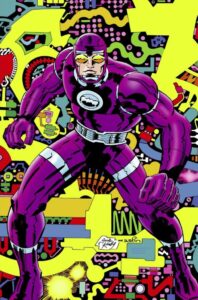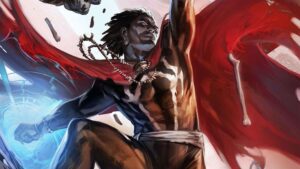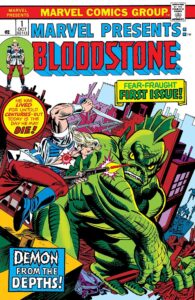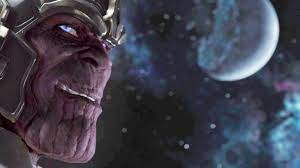For any die-hard Marvel comics fans, here are a few lesser-known characters that could deserve their own Disney+ debuts
People who have not been living in a bomb shelter for the last fifteen years already know that the Marvel Cinematic Universe is hot (If you have, let me be first to tell you that you look great). They’ve been hot since Robert Downey Jr. donned his iron longjohns back in 2008. Now that Disney has taken the reins, Marvel’s been running wild with a bunch of new projects that promise to keep the MCU franchise going for years to come.
Still, it’s hard for me to think of any substantial Marvel character who hasn’t made it yet onto the big screen, Disney+, Hulu, or Netflix. Mind you, not all of these character debuts have been hits (sometimes quite the opposite), with many having barely made a ripple whence they came.
Man-Thing quickly comes to mind. When he appeared in The Man-Thing (2005), practically no one had watched it—something which we should all be pretty happy about.
There are a lot of other Marvel characters though, that have surprisingly made their debut under the radar to most fans. Especially, some relatively obscure characters who had happened to have made it to Netflix.
Fans of Jessica Jones (Season 3) may not have known dormant characters like Greg Salinger (Foolkiller) and Dr. Karl Malus. These characters haven’t appeared in comic books for a while, but in Jessica Jones, they certainly made formidable antagonists.
Even characters like Tilda Johnson (Nightshade) made it into Luke Cage (Season 2). If you were a comic fan, you knew her biggest contribution to Marvel’s continuity was turning the Falcon into a chemically-mutated werewolf. In Luke Cage, though, she’s just plain terrifying as a rejected daughter. The MCU gave her a new life.
Marvel features a lot of these: characters that were either killed off or shelved or not used. That said, I’d like to suggest three relatively obscure Marvel characters that I think might resonate with new audiences.
Let’s begin with…
Machine Man

Jack Kirby along with Stan Lee and Steve Ditko get credit for coming up with many of Marvel’s greatest creations. However, some of them have been awesome while flying inconspicuously under the radar.
Such a character is Machine Man, created back in 1977. He was written and drawn by Jack Kirby in 2001: A Space Odyssey #8.
Yes, you read that right.
Jack Kirby wrote a comic series based on the premises introduced in Stanley Kubrick’s film as written by Arthur C. Clarke. And it was great.
Originally introduced as “Mister Machine”, Machine Man (aka X-51) was the last of fifty-one artificial intelligence android prototypes. All of them had the potential to reach emotional sentience.
Dr. Abel Stack was a robotic expert who took X-51 and developed his consciousness differently. Stack theorized that if a robot were to think like a man, he should be treated like one. He raised X-51 as if it were his son. He even went so far as to create a human face for the robot.
Meanwhile, the other fifty prototypes went psychotic after they had gained sentience. They were not prepared to understand their own identity. As a result, the project was terminated. Each prototype was destroyed through a remote-controlled self-destruct device. Dr. Stack was in the process of removing the device when the remote signal was sent and killed him instantly.
X-51 survived.
The robot disguised itself as human and went into society under the alias of Aaron Stack, an insurance investigator.
While the character is rarely used, Machine Man springs up in the Marvel Universe from time to time. Recently, he was the main protagonist in the third volume of Marvel Zombies.
As far as finding a place for him in the Marvel Cinematic Universe, it shouldn’t be too hard. The newly reconstructed Vision is still an open plot hole. If they don’t give X-51 his own limited series run, he could certainly be a supporting character in any of the new upcoming Marvel projects.
Brother Voodoo

Being Brother Voodoo means that you’re never alone.
In case you haven’t figured it out, Brother Voodoo practices voodoo. Much like Doctor Strange, Brother Voodoo is an actual doctor (psychologist) who studied the mystic arts of Voodoo.
His real name is Jericho Drumm. When he returned to his native home in Haiti, he found his twin brother, Daniel, the local houngan, dying from a voodoo curse. Daniel made his brother promise to study under his spiritual mentor, Papa Jambo. Jericho did and mastered the voodoo arts based on the Loa, the spirit-gods of voodoo. With that, he also learned how to join his soul and summon his dead brother’s spirit to use to possess other people.
Hence, Brother Voodoo.
Brother Voodoo came onto the Marvel scene back in the seventies when voodoo movies and voodoo zombies were in vogue. However, relatively recently (2009), the character was reintroduced as Doctor Strange’s successor to the mantle of the Sorceror Supreme.
I see a lot of possibilities with this character—again this would be under the Doctor Strange franchise. Both Doctor Strange and Brother Voodoo are cut from the same cloth. As the Darkhold has been reintroduced into the MCU through WandaVision, there is going to be a need for more mystical supporting characters.
Brother Voodoo could also appear in the new Werewolf by Night coming to Disney+. This character might serve as a mystic master as there are mystical monsters around. Having a real magician about could be handy.
Bloodstone

While I’m on the topic of heroes fighting monsters, let’s talk about Ulysses Bloodstone.
The easiest way to describe Bloodstone is “Highlander meets Lovecraft’s Cthulhu”.
Bloodstone’s actual origin story goes all the way back to 8250 BCE. That’s the Hyborian Age. The man who would become Bloodstone was hunting when he came upon the extradimensional being, Ulluxy’l Kwan Tae Syn, who was the guardian of the bloodstone, a crystal of great mystical power.
Ulluxy’l Kwan Tae Syn (Marvel’s version of Cthulhu at the time) offered the hunter physical power through the bloodstone—which granted him great strength. The hunter returned to his tribe and told them how they could also have these powers. When they returned to Ulluxy’l Kwan Tae Syn with him, the bloodstone killed them all.
The hunter tried to stop it by destroying the stone. The bloodstone exploded and lodged a large piece into the hunter’s sternum. The rest of the pieces scattered themselves across the planet.
The bloodstone in the hunter’s chest gave him practical immortality. He renamed himself “Ulysses Bloodstone” and vowed revenge against Ulluxy’l Kwan Tae Syn and his agents.
In short, Bloodstone became a monster hunter. Originally his stories were published as a vehicle to write Lovecraftian horror stories where a hunter could battle these terrors.
Ulysses Bloodstone had some decent powers, too. He could press about five tons. He did not age—which was handy because he built a vast fortune through the millennia to fund his missions. People who live that long also have the opportunity to master languages and fighting styles. Bloodstone mastered all of them. Plus, he had an accelerated healing factor and an invisible “third eye” which granted him extrasensory perception.
Put all this stuff together and it’s pretty cool.
The neat thing is that Marvel killed off the character back in Rampaging Hulk #8. However, he has subsequently been brought back in flashback stories of The Monster Hunters in the Marvel Universe (1998) which took place in the 1950s.
This character has never been introduced in the MCU which means he’s a great character to reintroduce in other stories.
Consider the character of Moon Knight. Marc Spector was a mercenary for hire who somehow got mixed up with supernatural Egyptian gods. Why not use Bloodstone in that story?
Ulysses Bloodstone is what I call a disposable character. These largely forgotten characters have no impact on the continuity in the Marvel Universe. Writers have nothing to lose by killing them off.
It’s worked before.
The characters of Drax the Destroyer, Gamora, and even Star-Lord were gathering dust on the shelves for decades before the Marvel series, Annihilation (2006) and Annihilation Conquest (2007) were written. That series launched The Guardians of the Galaxy (as we know them today).
Obscure Characters and Easter Eggs
I’ve followed the Marvel Universe for about fifty years. I’m not exaggerating.
My view of the MCU is unique. I know most of these characters when I see them. I find it interesting when I see dead or rarely used characters appear in film.
Interesting is a good word.
I immediately think, “What a great opportunity. This should be interesting!”
When new writers dust off characters to give them a new chance, it’s exciting. For example, in Netflix’s Jessica Jones, Doctor Karl Malus was brought back. I was excited. Things would happen. Malus’ experiments caused trouble. The protagonist would need to stop them.
When Phineas Mason (the Tinkerer) appeared in Spider-Man: Homecoming, it signaled to me that people did their homework. It meant to me that the Vulture would instantly be more dangerous because he had new tech. New possibilities could always happen.
It is magical when you think about it.
The instance that stands out in my mind was when I saw the first Avengers movie. It was a treat because I saw it in a 3D IMAX format. It was like being in the movie. Seriously. I stuck around for the end credits because of course I did.

And what happened?
Thanos happened.
Ten percent of the audience gasped. The other ninety percent had no idea why because they’d never heard of Thanos.
My friends and I started back to the car and some guy heard me talking to them about Thanos.
“Who is that guy at the end?” He said.
“Thanos.”
“Who’s he?”
And I felt bad because I didn’t have the time to condense everything I knew about Thanos. I couldn’t boil down The Life of Captain Marvel, Jim Starlin’s run of Warlock, and The Infinity Gauntlet for him.
So I just said, “He’s a really big bad scary villain.”
“Oh.”
To him, Thanos was new. To me, it was the entrance of something interesting.
And that’s what we have to remember about Marvel. The mythology is huge. It’s rich in its character resources and movie producers shouldn’t lose an opportunity to reintroduce these lesser-known characters to new audiences.
